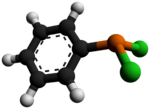Chemistry:Dichlorophenylphosphine
From HandWiki

| |

| |
| Names | |
|---|---|
| Preferred IUPAC name
Phenylphosphonous dichloride | |
| Other names
Dichlorophenylphosphane
Phenylphosphorus dichloride | |
| Identifiers | |
3D model (JSmol)
|
|
| ChEMBL | |
| ChemSpider | |
| EC Number |
|
PubChem CID
|
|
| RTECS number |
|
| UNII | |
| UN number | 2798 |
| |
| |
| Properties | |
| C6H5Cl2P | |
| Molar mass | 178.98 g·mol−1 |
| Appearance | colorless liquid |
| Odor | acrid, pungent |
| Density | 1.3190 g/mL |
| Melting point | −51 °C (−60 °F; 222 K) |
| Boiling point | 222 °C (432 °F; 495 K) |
| insoluble | |
| Solubility | miscible in benzene, CS2, chloroform |
Refractive index (nD)
|
1.6030 |
| Hazards | |
| Safety data sheet | Fisher MSDS |
| GHS pictograms |   
|
| GHS Signal word | Danger |
| H290, H301, H302, H314, H335 | |
| P234, P260, P261, P264, P270, P271, P280, P301+310, P301+312, P301+330+331, P303+361+353, P304+340, P305+351+338, P310, P312, P321, P330, P363, P390, P403+233, P404, P405, P501 | |
| NFPA 704 (fire diamond) | |
| Flash point | 101 °C (214 °F; 374 K) |
| 159 °C (318 °F; 432 K) | |
| Lethal dose or concentration (LD, LC): | |
LD50 (median dose)
|
200 mg/kg (oral, rat) |
Except where otherwise noted, data are given for materials in their standard state (at 25 °C [77 °F], 100 kPa). | |
| Infobox references | |
Tracking categories (test):
Dichlorophenylphosphine is an organophosphorus compound with the formula C6H5PCl2. This colourless viscous liquid is commonly used in the synthesis of organophosphines.
Dichlorophenylphosphine is commercially available. It may be prepared by an electrophilic substitution of benzene by phosphorus trichloride, catalyzed by aluminium chloride.[1][2] The compound is an intermediate for the synthesis of other chemicals for instance dimethylphenylphosphine:
- C6H5PCl2 + 2 CH3MgI → C6H5P(CH3)2 + 2 MgICl
Many tertiary phosphines can be prepared by this route.[3]
In the McCormack reaction dichlorophenylphosphine adds dienes to give the chlorophospholenium ring.[4]
Reductive coupling of the dichlorophosphine gives the cyclophosphine (PhP)5.[5]
References
- ↑ B. Buchner; L. B. Lockhart, Jr. (1951). "Phenyldichlorophosphine". Organic Syntheses 31: 88. doi:10.15227/orgsyn.031.0088.
- ↑ Engel, Robert; Cohen, Jaime-Lee Iolani (2004). Synthesis of Carbon–Phosphorus Bonds. CRC. ISBN 0-8493-1617-0.
- ↑ P. Loeliger E. Flückiger (1976). "Sulfide Contraction via Alkylative Coupling: 3-Methyl-2,4-heptanedione". Organic Syntheses 55: 127. doi:10.15227/orgsyn.055.0127.
- ↑ W. B. McCormack (1963). "3-Methyl-1-Phenylphospholene oxide". Org. Synth. 43: 73. doi:10.15227/orgsyn.043.0073.
- ↑ Marianne Baudler, Klaus Glinka (1993). "Monocyclic and Polycyclic Phosphines". Chem. Rev. 93: 1623–1667. doi:10.1021/cr00020a010.
 |



